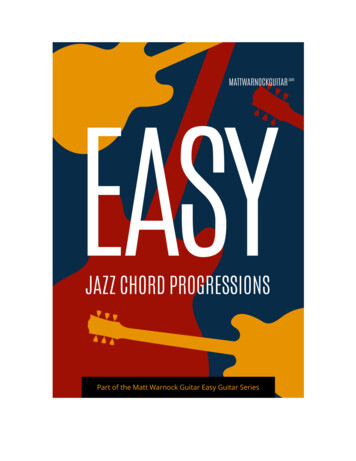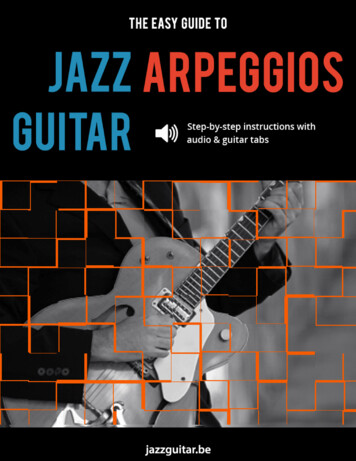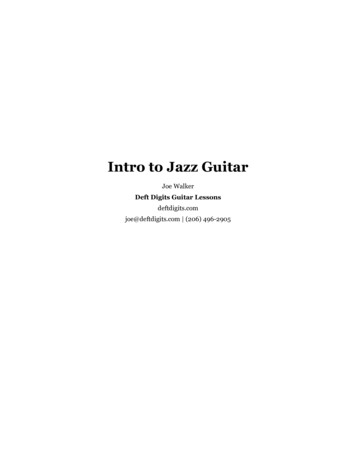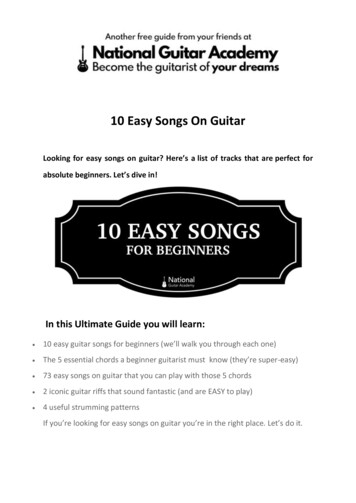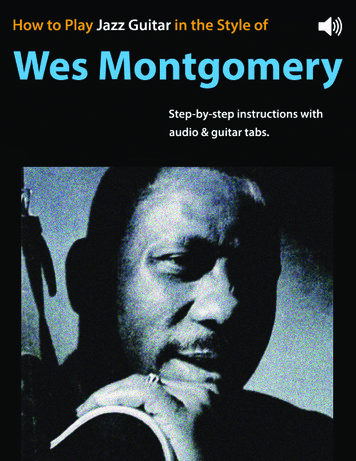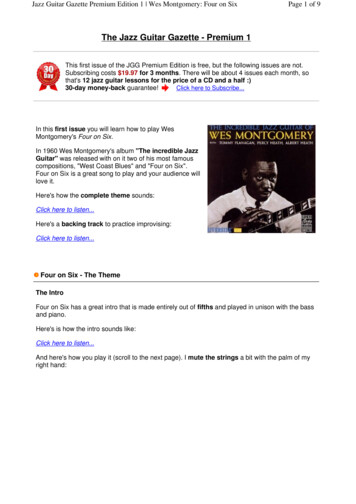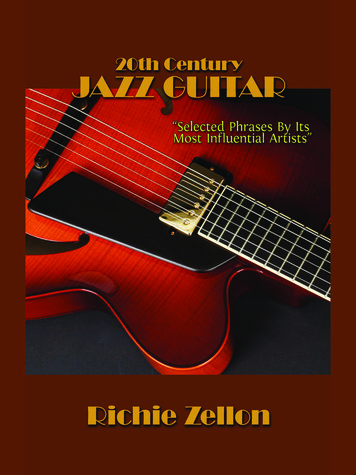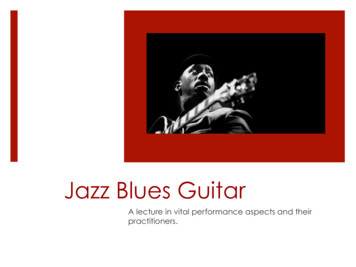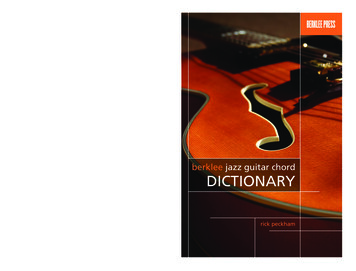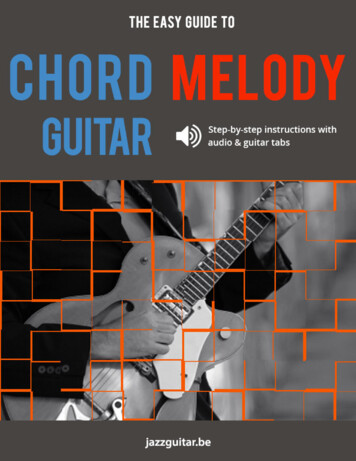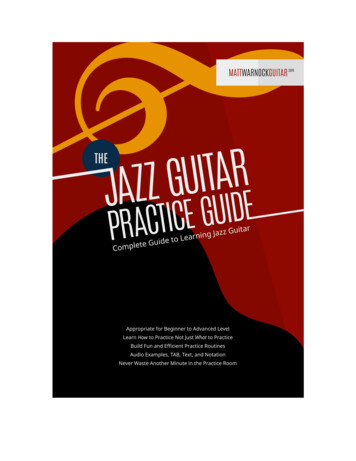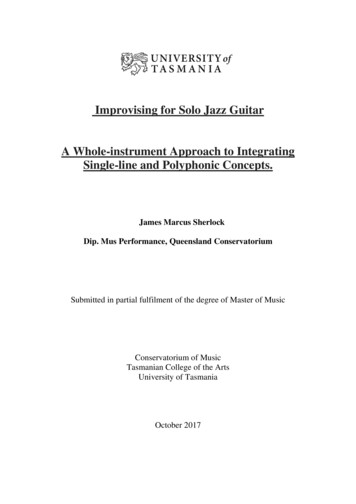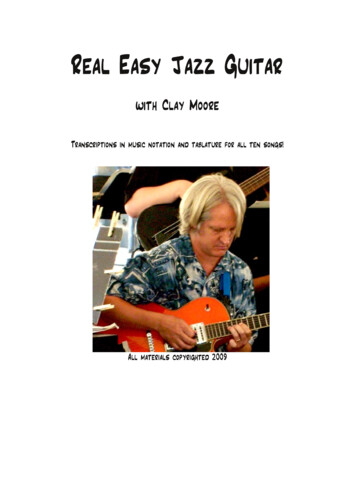
Transcription
Real Easy Jazz Guitarwith Clay MooreTranscriptions in music notation and tablature for all ten songs!All materials copyrighted 2009
ForwardGreetings, fellow jazz guitar enthusiast,Thanks for purchasing the Real Easy Jazz Guitar course. When Claude Johnson firstcontacted me about this project I was very excited, because I had already been thinking abouta course like this for some time, based on simple, easy-to-play versions of the standards thatworking jazz musicians play. In each of the ten songs/lessons you’ll not only be learning thebasic chords, scales, and arpeggios needed for those songs, but the basic tools you can useany jazz setting, from playing solo to playing in full on jazz orchestra. You’ll also learn how todecode seemingly complicated chord progressions, reducing them into simple, easy tounderstand chunks.Claude’s idea of combining the course with The New Real Book was a stroke of genius, awin-win for everyone. Chuck Sher’s New Real Book series set a standard for jazz books thateveryone else has scrambled to emulate, leaving the old inaccurate, illegal fakebooks in thedust. As you master the material in the Real Easy Jazz Guitar course you’ll have the skills tokeep learning and progressing from The New Real Book for years to come.Of course no one can do it alone, and special thanks go out to Derek Lau , Dylan Stern,and Elias Swinehart, the crew who worked so hard during the filming and editing of this course,to Claude for his vision, creativity, good hosting, and stamina, and to my good friends Harry“Jack” Rudy and Bob Beach, who took time from their busy schedules to hang out with an oldpal from out of town.Musically yours,Clay Moore
Chapter One - Basic concepts: the 7 chords in any keyLike I said in the video, you have to walk before you run, so before we get to our first songwe need to learn some chords, scales, and arpeggios. The lesson below is about the 7 chordsin the key of C major. In traditional music theory those chords are:·······C majorD minorE minorF majorG major or G7A minorB diminishedIn jazz we routinely use 7th chords instead of the basic triads above, so the list becomes:·······C major7D minor7E minor7F major7G7A minor7B minor7 flat 5, a.k.a. B half diminished7These chord names are shortened to make them easier and quicker to read, so the new andimproved list is:·······Cmaj7Dm7Em7Fmaj7G7Am7Bm7b5In the exercise that follows, we will learn these 7 chords in the key of C major in the 7thposition*, along with a two octave C major scale, scales for each chord, and the accompanyingarpeggios. Learn these fingerings, names, and sounds until you can play them in your sleep.*7th position means your first finger on your fretting hand is at the 7th fret.
Side note:Chords in any major key can be named by their letter name, as in Cmaj7, Am7, etc., and bytheir number in the scale, using Roman numerals. In the key of C major, Cmaj7 is also knownas the I chord, Am7 as the vi chord, and so on, using upper case numerals for major7 and 7thchords, and lower case numerals for minors and minor7 flat fives. In C it would look like this:·······The I chord is Cma7The ii chord is Dm7The iii chord is Em7The IV chord is Fmaj7The V chord is G7The vi chord is Am7The vii chord is Bm7b5From this specific example in C major we learn a general rule, the I chord in any major keyis maj7, the ii is m7, and so on. In the key of Ab, for example, the chords become:·······The I chord is Abma7The ii chord is Bbm7The iii chord is Cm7The IV chord is Dbmaj7The V chord is Eb7The vi chord is Fm7The vii chord is Gm7b5You'll want to make it a long term project to know these basic chords backwards andforwards in every key.
Chapter One Addendum – decoding complex jazz chordsIt’s easy to get confused by all the crazy sounding names for jazz chords, such as Bmaj9#11,Fm6/9, or Db13b9. But fear not, the vast majority of jazz chords can be reduced to just threetypes:···Major chordsMinor chordsDominant 7th chord, a.k.a. 7If a chord has M, MA, maj, or a triangle after the letter, it’s a major-type chord, and we canuse the maj7. Bmaj9#11 then becomes Bmaj7.If a chord has MI, m, min, or a minus sign (–) after the letter, it’s a minor chord, and we canusually substitute the m7. Fm6/9 becomes Fm7.If a chord has a number 7 or larger after the letter it's a 7th chord, also called a dominant 7th.Db13b9 is D7.
Chapter Two – Dearly BelovedThis is a perfect song to get started with, because it’s extremely easy, but changes keysbriefly twice during the progression, giving you a chance to get your feet wet soloing with yournewly-learned scales and arpeggios. Almost all jazz songs move around to different keys, so byanalyzing this simple progression you’ll learn how to figure out much more complicated oneswith ease. Here’s how we do it.In any major key there are two maj7 chords, three m7 chords, but only one 7th chord, whichis the V chord. In the key of C major the V chord is G7. Dearly Beloved starts out in C majorwith the chords Dm7, G7, and Cmaj7* (the written chord in The New Real Book is C6. UseCmaj7, and we’ll explain later). In measures 15 and 16, however, the chords are Ebm7 and Ab7,neither of which is one of the 7 chords we learned in the key of C. But we know 7th chords areV chords, so Ab7 is the V chord in Db major (count backwards. Ab, Gb, F, Eb, Db). Now we caneasily see that Ebm7 is the ii chord in Db, so for those two measures we’re in the key of Db.Move your C major scale fingering from the 7th to the 8th fret and you’re good to go.For the rest of the song the chords move between Dm7, G7, and C, except for measures 27and 28, where the chord is D13. D13 is a 7th chord with some extra notes, which are notnecessary right now. Instead we’ll play D7, which is the V chord in G major (D, C, B, A, G). Ourmajor scale fingering moves to the 2nd fret, and we’re in G for those two measures, then backto 7th fret in measure 29. That’s all the analysis you need!Quick road map:Measures 1-14 in C majorMeasures 15-16 in Db majorMeasures 17-26 in C majorMeasures 27-28 in G majorMeasures 29-32 in C majorTip:Check out guitarist Wes Montgomery’s great recording of Dearly Beloved, which he plays inthe key of G major.*C6, also known as Cmaj6, is a major-type chord very similar in sound and usage to theCmaj7. You often see the maj6 chord in songbooks when the melody note is the same lettername as the chord root, but the maj7 chord works just fine as well.The music on the next two pages is the transcription of the melody and solo as played onthe DVD.
Chapter Three - Autumn LeavesNext we're going to tackle a very well-known standard called Autumn Leaves. This song hasbeen recorded countless times by such artists as Joe Pass, Wynton Marsalis, Kenny Burrell,Chick Corea, and Miles Davis. Two of my favorite versions include Nat King Cole's beautifulballad rendition with strings, and Cannonball Adderly's recording on his album called Somethin'Else.Autumn Leaves is fairly simple to play and improvise on, because even though it changeschords frequently it centers on the key of Bb major and its relative minor key of G minor.Cannonball's recording is in the same key as The New Real Book, but he uses simpler changes,staying on Bbmaj7 in measure 24 instead of changing to Ebmaj7, and omitting the C9, Fm7, andBb7 in measures 27 and 28, staying on Gm. I've based the Real Easy Jazz Guitar version onCannonball's changes.As far as analyzing the progression, the only chord that deviates from the diatonic chords (inthe key) in Bb is the D7, which acts as a V chord going to Gm. When you improvise you can addthat F# note to the Bb/Gm scale when you're on the D7 - it makes a nice sound.The chords below are all the ones you'll need to play Autumn Leaves, including two ways toplay both the D7 and Gm7 chords.The following three pages is Autumn Leaves from the DVD, with an improvised solo.
Next is a comping example using the basic chords. Note the varied rhythms andembellishments used.
The next two pages of music is a solo exercise, playing the scales in Bb/Gm, starting with theroot of each chord and playing in 8th notes up to the octave. Once you get the hang of this typeof drill you can create all kinds of variations, such as playing the scales backwards, or play onescale going up and the next coming down.
Chapter Four - Blue BossaBlue Bossa was written by Texas trumpeter Kenny Dorham, which he first recorded on JoeHenderson's debut album, Page One. The title refers to the Brazilian style of music known asbossa nova, which means "new thing" in Portuguese. During the 1960s many North Americanmusicians became interested in this beautiful music, with its lilting rhythms and jazz harmonies.Blue Bossa uses two keys, C minor for eight measures, Db major for four measures, andback to C minor for four measures. We'll be using a new scale postion for these keys, whichwe'll start with below.The same scale moved from the 5th fret to the 3rd fret gives us our Db major scale andchords.Next we'll move on to the DVD recorded version with the improvised solo and comping.You'll notice I played a lot of double-time runs, but it certainly isn't necessary for a good solo.Listen to Page One and check out how Kenny Dorham stays mostly to the melody for his solo.
The next page is a basic bossa nove rhythm you can use for comping. Once you master thisyou'll want to get ahold of some genuine Brazilian music, such as Antonio Carlos Jobim, BadenPowell, and Bola Sete, and copy what they do.
Our final example for Blue Bossa is the simplified melody and a solo exercise similar to theone we learned for Autumn Leaves.
Chapter Five - Here's That Rainy DayHere's That Rainy Day gives us the opportunity to learn a full chord melody, using thechords we've learned from our two major scale forms. When you're learning these it's best tofollow Joe Pass's advice and not worry about putting it into tempo right away. The mostimportant thing about chord melody is stating the melody clearly and with good expression, sopractice playing rubato (no steady or fixed tempo) until you can play it smoothly in your sleep.Then, and only then will you want to begin putting it into a slow tempo.Here's That Rainy Day also takes a leap forward from the soloing we've been doing in oneof two keys, moving through G major, Eb major, Bb major, and a couple of temporary trips into Cand D major. Note that the Dm7 to G7 in measure 8 takes you into a Cm7 chord - the ii chord inBb - and in meaure 16 into Cmaj7. The A7 chord in measure 20 doesn't resolve into D, but youstill will want to solo using the D major or A mixolydian (same notes, different ways of looking atthem) .
Chapter Six - Gee Baby, Ain't I Good To YouThis tune isn't as well-known as some of the others we've covered so far, but it's anotheropportunity for us to learn a chord melody with a bluesy flavor. Along the way we'll get to learnsome new chords and apply some familiar ones in new ways.One chordal concept that you can begin to apply is substitute chords. A substitute chord isone used in place of another. One simple way to get started is to use chords we already know inthe major keys, by substituting a chord a 3rd higher or lower than your original chord.For Cmaj7 substitute Em7 (3rd higher) or Am7 (3rd lower). Em7 for Cmaj7 gives us a Cmaj9sound. Am7 gives us a C6 sound. Hint: use voicings that have the roots on higher pitchedstrings.In this song we use Cm7b5 for Ab7 (Ab9) and Em7b5 for C7 (C9). Cool trick, yes?Another note. I've written the time signature as 12/8 instead of 4/4. 12/8 gives us that tripletdrenched sound of slow blues, without having to read (and write!) all those cumbersome triplets.You can still count it in as a slow 4/4, but also hear the underlying 1 2 3, 4 5 6, 7 8 9, 10 11 12.
The next example is a solo exercise using mostly arpeggios on each of the chords. On asong such as this, where you're changing chords every couple of beats you'll want to get reallycomfortable with outlining the notes in those chords, and that means arpeggios!
Chapter Seven - SanduThere's saying that all jazz comes from the song I Got Rhythm and the blues. Sandu is ablues written and recorded by the fantastic trumpeter Clifford Brown. It's a catchy little melodyand offers some challenges to us that we've not seen yet in this course. In order to emulate thetrumpet and saxophone type phrasing you have to pay strict attention to the fingerings in thetab. Blues in jazz is the most versatile music, because you can play as simply as you want,using the notes of the blues scale, or as complex as you dare, with altered dominant chordsand exotic scales.
Next up is the transcription of the comping example.
And last here's how to play Sandu in both low and high octaves, a cool variation.
Chapter Eight - TenderlyTenderly is a beautiful standard that can be played as a ballad, swing, or bossa nova. Hey,this is a good time to mention that you can do that! It's a good idea to practice all your tunes in avariety of keys and rhythmic feels. And be sure you know the melodies by themselves, not justas chord melodies, and practice comping and soloing on all the tunes. Jazz is all about beingversatile in how you approach material.The first page that follows is a simple chord melody version, suitable for a rubato solo piceor with a group. Following that is a bit more embellished version with an improvised solo.
Chapter Nine - St. ThomasSt. Thomas was written and recorded by Sonny Rollins, and it is a perennial jam sessionfavorite. Rollins' version is taken at a medium tempo, but it often is played much faster, whichcan make it a bit more difficult to solo on. Fortunately the changes are fairly simple and you canget by with using the C major or even C major pentatonic scale.You'll want to start with learning the melody slowly, with good time and articulation.On the following pages is the transcription of the DVD version. Notice that I'm emb
newly-learned scales and arpeggios. Almost all jazz songs move around to different keys, so by analyzing this simple progression you’ll learn how to figure out much more complicated ones with ease. Here’s how we do it. In any major key there are two maj7 chords, three m7 chords, but only one 7th chord, which is the V chord. In the key of C major the V chord is G7. Dearly Beloved starts out in C major
